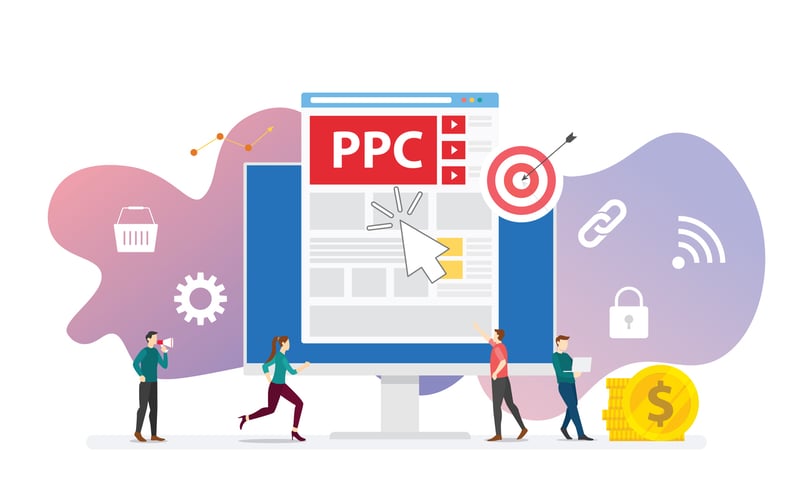Che cos'è il retargeting e come si usa con la pubblicità a pagamento?
Vi è mai capitato di andare a vedere un sito di viaggi e di vederne la pubblicità la volta successiva che aprite il computer? Oppure continuate a vedere annunci per le scarpe che avete "quasi" comprato? Il retargeting è uno strumento potente che mostra annunci a potenziali clienti che hanno già visitato il vostro sito web.
Quindi, come si può far funzionare il retargeting per voi e come coincide con la pubblicità a pagamento?

Che cos'è il retargeting?
Ilretargeting, detto anche remarketing, è una sofisticata strategia di marketing digitale progettata per coinvolgere nuovamente gli utenti che hanno precedentemente interagito con il sito web o i contenuti online di un marchio. Il retargeting sfrutta le tecnologie di tracciamento, come i cookie o i pixel, per seguire il comportamento online degli utenti. Quando un utente visita un sito web ma non completa un'azione desiderata, come ad esempio un acquisto, il retargeting consente agli inserzionisti di mostrare annunci mirati a questi visitatori mentre navigano su altri siti.
Il retargeting è fondamentale per rafforzare la consapevolezza del marchio , mantenendolo sotto i riflettori dei potenziali clienti. Quando gli utenti incontrano annunci mirati su diverse piattaforme online, il marchio diventa una presenza familiare, favorendo la fiducia e il riconoscimento. Questa esposizione ripetitiva contribuisce a consolidare il marchio nella mente dell'utente, aumentando la probabilità che ritorni per la conversione, che sia un acquisto o un'altra azione desiderata.
Al di là della brand awareness, il retargeting eccelle nell'alimentare i lead e nel facilitare le conversioni. Le aziende possono guidare i potenziali clienti attraverso l'imbuto di vendita, adattando gli annunci al comportamento specifico degli utenti. Che si tratti di mostrare prodotti lasciati nel carrello o di promuovere offerte esclusive basate su interazioni precedenti, il retargeting trasforma l'interesse casuale in coinvolgimento attivo. Questo approccio personalizzato aumenta notevolmente le possibilità di convertire i contatti in clienti fedeli, massimizzando il ritorno sull'investimento per gli sforzi pubblicitari.
I marchi che utilizzano annunci di retargeting registrano un aumento delle ricerche del 1046%.
Nel complesso, il retargeting è uno strumento dinamico che mantiene il marchio in primo piano nella mente del consumatore e lo guida attivamente verso interazioni significative, contribuendo in ultima analisi al successo di una strategia di marketing digitale completa.
La meccanica del retargeting
Retargeting basato sui cookie
Abbiamo parlato di cookie, ma non di quelli che si mangiano. Forse vi ricorderete di aver visitato un sito web e di aver fatto clic su "Accetta tutti i cookie" per far scomparire un pop-up, anche se forse non sapete cosa significhi per voi come utenti del web.
Il retargeting basato sui cookie è la spina dorsale di questa potente strategia di marketing. I pixel di tracciamento e i cookie sono piccoli pezzi di codice incorporati in un sito web che tracciano in modo anonimo le attività degli utenti. Quando un utente visita un sito, il cookie viene memorizzato nel suo browser, registrando informazioni come le pagine visualizzate, i prodotti esplorati o le azioni intraprese. I pixel di tracciamento sono essenzialmente immagini trasparenti di 1x1 pixel che attivano il caricamento dei cookie quando vengono visualizzati sul browser dell'utente. Questo sistema di tracciamento continuo consente agli inserzionisti di creare un profilo dettagliato del comportamento online di un utente.
I dati raccolti attraverso i cookie costituiscono la base delle campagne di retargeting personalizzate. Permettono agli inserzionisti di capire le preferenze degli utenti, i prodotti o i servizi a cui sono interessati e le fasi del percorso dell'acquirente che hanno raggiunto. Questi dati preziosi vengono poi sfruttati per creare contenuti pubblicitari mirati, assicurando che agli utenti vengano presentati annunci in linea con le loro precedenti interazioni. Fornendo contenuti pertinenti in base al comportamento degli utenti, il retargeting basato sui cookie massimizza le possibilità di coinvolgere nuovamente gli utenti e di spingerli a compiere le azioni desiderate.
Retargeting basato su elenchi
Il retargeting basato su elenchi sposta l'attenzione dai visitatori anonimi dei siti web a individui identificati. Le aziende possono creare elenchi di clienti raccogliendo informazioni di contatto attraverso iscrizioni, acquisti o altre interazioni. Questi elenchi diventano uno strumento potente per creare campagne altamente mirate. Caricando questi elenchi sulle piattaforme pubblicitarie, le aziende possono rivolgersi in modo specifico ai clienti esistenti con messaggi personalizzati. Questo metodo è particolarmente efficace per le campagne di fidelizzazione, l'upselling o la promozione di offerte esclusive a un pubblico noto.
Il retargeting basato sulle liste consente un approccio sfumato alla messaggistica. Le aziende possono personalizzare la comunicazione in base alle azioni specifiche compiute dagli utenti. Che si tratti di riconoscere un acquisto recente, di suggerire prodotti complementari o di coinvolgere nuovamente i clienti inattivi, il retargeting basato su liste consente interazioni altamente personalizzate. Questa comunicazione personalizzata migliora il coinvolgimento degli utenti e favorisce un senso di connessione, aumentando la probabilità di ripetere l'attività e di fidelizzare i clienti.
Integrazione del retargeting con la pubblicità a pagamento
Ottimizzazione del contenuto degli annunci
Per quanto riguarda il retargeting, il contenuto dell'annuncio è il ponte che riconnette i potenziali clienti. Immagini convincenti e testi persuasivi sono le chiavi per catturare l'attenzione e riaccendere l'interesse. Gli elementi visivi devono essere accattivanti, trasmettere l'essenza del marchio e mostrare prodotti o servizi in linea con le precedenti interazioni dell'utente. Allo stesso tempo, il testo deve essere conciso, persuasivo e adatto a rispondere alle esigenze o alle preoccupazioni dell'utente. Creare una narrazione che risuoni emotivamente e che evidenzi la proposta di valore è essenziale per riaccendere l'interesse dell'utente.
Allineare i messaggi di retargeting al comportamento dell'utente
Il successo del retargeting si basa sull'invio di messaggi che rispecchiano il percorso dell'utente. Allineando i contenuti a specifici comportamenti degli utenti, come i prodotti visualizzati, i carrelli abbandonati o le interazioni con il sito, le aziende possono creare un'esperienza personalizzata. Ad esempio, se un utente lascia degli articoli nel carrello, gli annunci di retargeting possono mettere in evidenza quei prodotti specifici e offerte o promemoria allettanti. Questo allineamento assicura che il contenuto sia pertinente e che serva da stimolo, guidando gli utenti verso il percorso di conversione in base ai loro interessi dimostrati.
Scegliere le piattaforme giuste
La scelta delle piattaforme giuste è fondamentale per il successo delle campagne di retargeting. Piattaforme come Google Ads e Facebook offrono solide funzionalità di retargeting, consentendo alle aziende di raggiungere gli utenti attraverso vari punti di contatto. La rete display di Google è particolarmente efficace per raggiungere gli utenti su molti siti web, mentre il retargeting di Facebook eccelle nello sfruttare il coinvolgimento sociale. La scelta delle piattaforme deve essere in linea con le abitudini e le preferenze online del pubblico target. Capire dove gli utenti sono più propensi a reinserirsi assicura che gli sforzi di retargeting siano concentrati dove producono il massimo impatto.
Le piattaforme dei social media e gli annunci display offrono una tela dinamica per le campagne di retargeting. Grazie alla loro vasta base di utenti, i social media consentono alle aziende di riconnettersi con il pubblico in un contesto sociale. D'altro canto, gli annunci display possono essere posizionati strategicamente sui siti web frequentati dai potenziali clienti, garantendo la visibilità del marchio. È fondamentale adattare i messaggi di retargeting al formato e al comportamento degli utenti di ciascuna piattaforma. Che si tratti di post sponsorizzati, annunci carosello o banner display dinamici, l'obiettivo è integrare perfettamente il retargeting nell'esperienza online dell'utente, aumentando le possibilità di reingaggio.
Strategie per campagne di retargeting efficaci
Segmentare il pubblico
La segmentazione è il cuore di un retargeting efficace, in quanto consente alle aziende di analizzare il proprio pubblico in base a comportamenti sfumati. Le aziende possono creare segmenti in linea con le diverse fasi del customer journey analizzando le interazioni degli utenti. Ad esempio, gli utenti che hanno navigato ma non hanno effettuato un acquisto o quelli che hanno abbandonato il carrello formano segmenti distinti. Ogni segmento rappresenta un'opportunità unica per strategie di retargeting personalizzate.
Una volta identificati i segmenti, diventa fondamentale creare messaggi che risuonino con ciascun gruppo. I contenuti devono rispondere alle esigenze, alle preoccupazioni o agli interessi di ciascun segmento. Per gli utenti che hanno abbandonato il carrello, può essere interessante enfatizzare uno sconto a tempo limitato o mostrare prodotti correlati. D'altro canto, gli utenti che hanno visitato più pagine ma non hanno convertito potrebbero rispondere meglio a una narrazione più ampia del marchio. Il segreto è adattare il messaggio di retargeting in modo che si allinei perfettamente al comportamento dell'utente all'interno del segmento identificato, creando un senso di personalizzazione che stimoli un rinnovato interesse e coinvolgimento.
Stabilire dei limiti di frequenza
Sebbene l'obiettivo del retargeting sia quello di rimanere al centro dell'attenzione, bombardare gli utenti con un numero eccessivo di annunci può portare alla stanchezza da pubblicità, riducendo l'efficacia della campagna. Il limite di frequenza è una soluzione strategica per evitare la sovraesposizione. Le aziende possono mantenere un delicato equilibrio fissando dei limiti al numero di volte in cui un utente vede un annuncio di retargeting in un determinato arco di tempo. In questo modo si evita il rischio che gli utenti si infastidiscano o si disinteressino a causa della ripetitività dei contenuti. L'affaticamento da annuncio può portare a una percezione negativa del marchio, sottolineando l'importanza dei limiti di frequenza come salvaguardia contro i rendimenti decrescenti.
Raggiungere il giusto equilibrio tra visibilità ed evitare di sopraffare il pubblico è una danza delicata. L'obiettivo è rimanere sufficientemente visibili per mantenere la propria rilevanza senza oltrepassare la soglia del fastidio. È fondamentale monitorare il coinvolgimento degli utenti e regolare i tetti di frequenza in base alle metriche di performance. Inoltre, la natura del prodotto o del servizio può influenzare le decisioni sul limite di frequenza. Gli acquisti ad alto coinvolgimento possono beneficiare di una strategia di visibilità più estesa, mentre i prodotti a basso coinvolgimento possono richiedere un approccio più conservativo.
Superare le sfide comuni
L'uso pervasivo degli ad blocker rappresenta un ostacolo significativo per le campagne di retargeting. Per superare questa sfida, le aziende possono adottare strategie come incentivare gli utenti a disabilitare i blocchi degli annunci o concentrarsi su formati pubblicitari nativi meno suscettibili di blocco. Anche la creazione di contenuti avvincenti e non intrusivi con cui gli utenti si impegnano volentieri può attenuare l'impatto dei blocchi degli annunci, garantendo che il messaggio di retargeting raggiunga il pubblico previsto nonostante questi ostacoli.
Il rispetto della privacy degli utenti è fondamentale nell'era della maggiore sensibilità ai dati. Trovare un delicato equilibrio tra personalizzazione e privacy è essenziale per il successo e l'etica delle campagne di retargeting. Una comunicazione chiara e trasparente sull'utilizzo dei dati e il rispetto delle norme sulla privacy creano fiducia negli utenti. L'utilizzo di dati anonimizzati e la garanzia di pratiche sicure rafforzano ulteriormente l'impegno nei confronti della privacy degli utenti.
Misurare il successo delle campagne di retargeting
L'efficacia di una campagna di retargeting dipende dal monitoraggio e dall'analisi meticolosa dei Key Performance Indicators (KPI). I tassi di click-through (CTR), i tassi di conversione e il ritorno sulla spesa pubblicitaria (ROAS) sono parametri fondamentali per valutare l'impatto degli sforzi di retargeting.
-
Il CTR misura il coinvolgimento degli utenti;
-
I tassi di conversione rivelano la capacità della campagna di convertire gli utenti interessati in clienti;
-
il ROAS fornisce informazioni sulla redditività della campagna.
L'identificazione dei KPI più rilevanti assicura una comprensione completa del successo della campagna, guidando le aziende a perfezionare le proprie strategie di retargeting per ottenere risultati ottimali. L'identificazione di schemi e tendenze consente di apportare modifiche strategiche, come l'affinamento dei segmenti di pubblico, la modifica dei contenuti degli annunci o l'ottimizzazione della tempistica degli sforzi di retargeting.
I test A/B sono un altro potente strumento che consente alle aziende di sperimentare diverse variabili per scoprire le strategie più efficaci. Nel contesto del retargeting, si tratta di testare variazioni nelle creatività degli annunci, nella messaggistica o persino nella tempistica di visualizzazione degli annunci. Ad esempio, due versioni di un annuncio di retargeting con immagini o inviti all'azione (CTA) diversi possono essere presentate a segmenti di pubblico distinti.
Liberare il retargeting con la pubblicità a pagamento
Nel panorama del marketing digitale in continua evoluzione, il retargeting si distingue come una forza dinamica, che migliora in modo significativo l'efficacia delle strategie pubblicitarie a pagamento. La capacità di coinvolgere nuovamente i potenziali clienti, di fornire loro messaggi personalizzati e di guidarli senza soluzione di continuità attraverso il percorso di conversione rappresenta una svolta per le aziende online.
Questo contenuto è disponibile in:
- Tedesco: Was ist Retargeting, und wie verwende ich es bei bezahlter Werbung?
- Inglese: What is Retargeting, And How Do I Use it with Paid Advertising?
- Spagnolo: ¿Qué es el retargeting y cómo se utiliza en la publicidad de pago?
- Francese: Reciblage : Qu'est-ce que c'est et comment l'utiliser en pub payante
- Rumeno: Ce este Retargeting-ul și cum îl folosesc în publicitatea plătită?
- Cinese: 什么是重定向,如何在付费广告中使用?

Joachim, formatore certificato HubSpot con oltre 13 anni di esperienza in Content Marketing, Strategia, implementazione di siti web e SEO, ha realizzato numerosi progetti di growth marketing internazionali su larga scala, ad esempio con UiPath, dallo status di startup fino alla quotazione in borsa (IPO) al NYSE. Joachim ha una competenza particolare in progetti multilingua di Marketing e Sales Enablement, sfruttando per i nostri clienti le più avanzate tecnologie di intelligenza artificiale (IA).








Facci sapere cosa ne pensi.